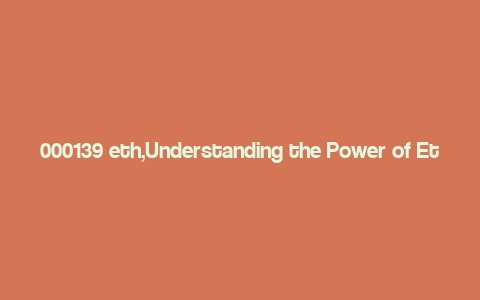Understanding the Power of Ethereum (ETH): A Comprehensive Guide
Ethereum, often abbreviated as ETH, has emerged as one of the most influential and widely-used cryptocurrencies in the world. With its unique features and capabilities, Ethereum has captured the attention of investors, developers, and enthusiasts alike. In this article, we will delve into the various aspects of Ethereum, providing you with a detailed and comprehensive understanding of this remarkable digital asset.
What is Ethereum (ETH)?
Ethereum is a decentralized platform that enables the creation of smart contracts and decentralized applications (DApps). Unlike Bitcoin, which is primarily a digital currency, Ethereum is a platform that allows developers to build and deploy applications that run on its blockchain. The native cryptocurrency of the Ethereum network is called Ether (ETH), which serves as the medium of exchange for transactions on the network.
The Ethereum Blockchain
The Ethereum blockchain is a decentralized ledger that records all transactions made on the network. It is maintained by a network of nodes, which are computers that run the Ethereum software and validate transactions. The blockchain is secure, transparent, and immutable, meaning that once a transaction is recorded, it cannot be altered or deleted.
One of the key features of the Ethereum blockchain is its ability to execute smart contracts. Smart contracts are self-executing contracts with the terms of the agreement directly written into lines of code. This eliminates the need for intermediaries, such as lawyers or brokers, and ensures that the terms of the agreement are enforced automatically.
Ether (ETH): The Native Cryptocurrency
Ether (ETH) is the native cryptocurrency of the Ethereum network. It serves as the medium of exchange for transactions on the network, allowing users to pay for gas fees, which are required to execute transactions and run smart contracts. Ether can be bought, sold, and traded on various cryptocurrency exchanges, and it can also be used to purchase goods and services from merchants that accept Ethereum.

The Ethereum Network
The Ethereum network is powered by a consensus mechanism called Proof of Work (PoW). PoW requires miners to solve complex mathematical puzzles to validate transactions and add new blocks to the blockchain. This process is energy-intensive and has led to concerns about the environmental impact of mining. As a result, Ethereum is working on transitioning to a more energy-efficient consensus mechanism called Proof of Stake (PoS).
Ethereum 2.0: The Future of Ethereum
Ethereum 2.0 is a major upgrade to the Ethereum network that aims to improve scalability, security, and sustainability. The upgrade includes the transition from PoW to PoS, which will reduce the energy consumption of the network. Additionally, Ethereum 2.0 will introduce a new token called ETH2, which will be used to incentivize validators to participate in the PoS consensus mechanism.
The Ethereum Ecosystem
The Ethereum ecosystem is vast and diverse, with thousands of developers, entrepreneurs, and investors actively involved. This ecosystem includes a wide range of projects, from decentralized finance (DeFi) platforms to non-fungible tokens (NFTs). The Ethereum network has become a hub for innovation and has paved the way for the development of a new generation of decentralized applications.
Conclusion
Ethereum (ETH) is a revolutionary technology that has the potential to transform various industries. With its decentralized platform, smart contracts, and native cryptocurrency, Ethereum has become a cornerstone of the blockchain industry. As the Ethereum network continues to evolve and improve, it is likely to play an even more significant role in the future of digital assets and decentralized applications.
| Feature | Description |
|---|---|
| Decentralization | Ethereum operates on a decentralized network, ensuring that no single entity has control over the platform. |
| Smart Contracts | Smart contracts are self-executing contracts with the terms of the agreement directly written into lines of code. |
| Scalability | Ethereum 2.0 aims to improve scalability, allowing for more transactions to be processed on the network. |
| Security | The Ethereum blockchain is secure, transparent, and immutable, ensuring the integrity of transactions. |